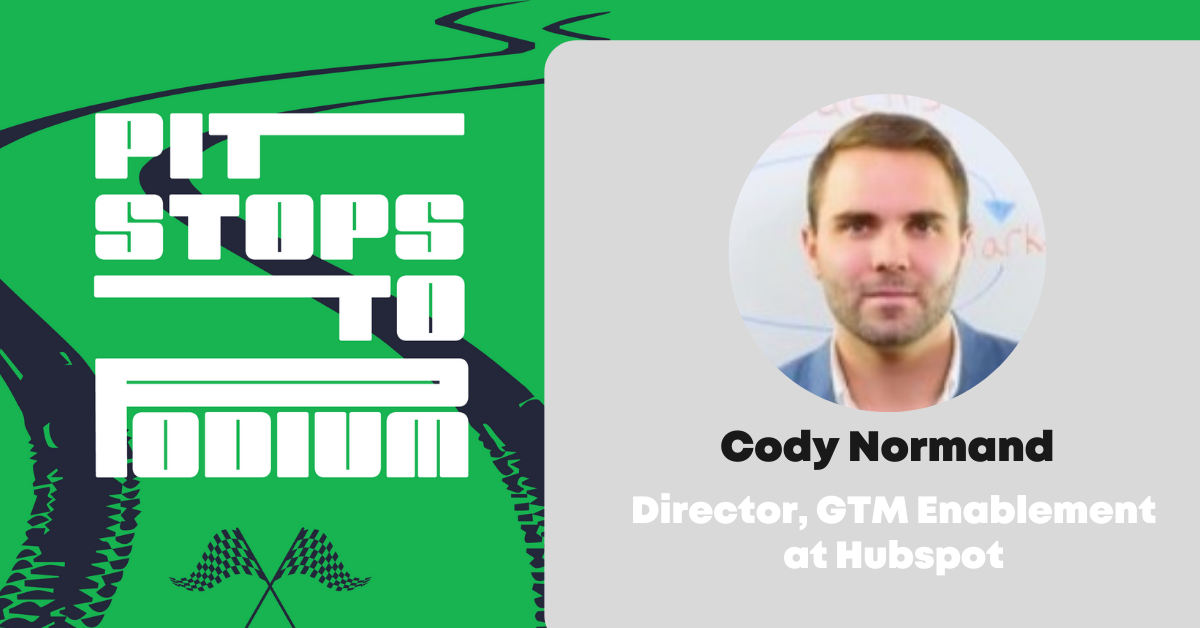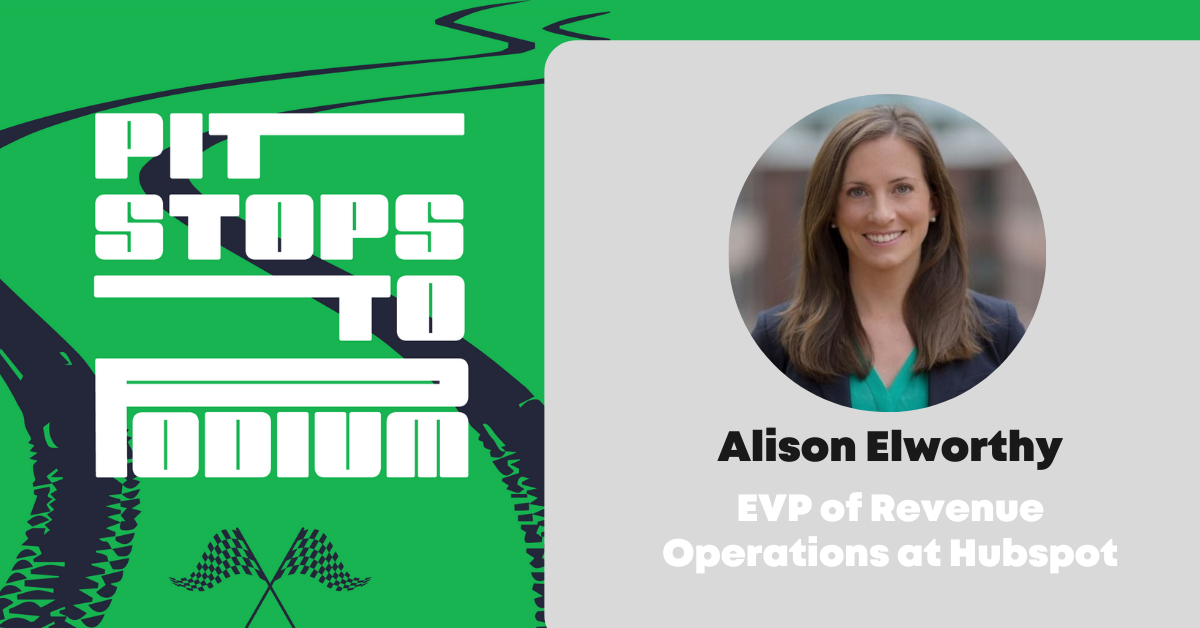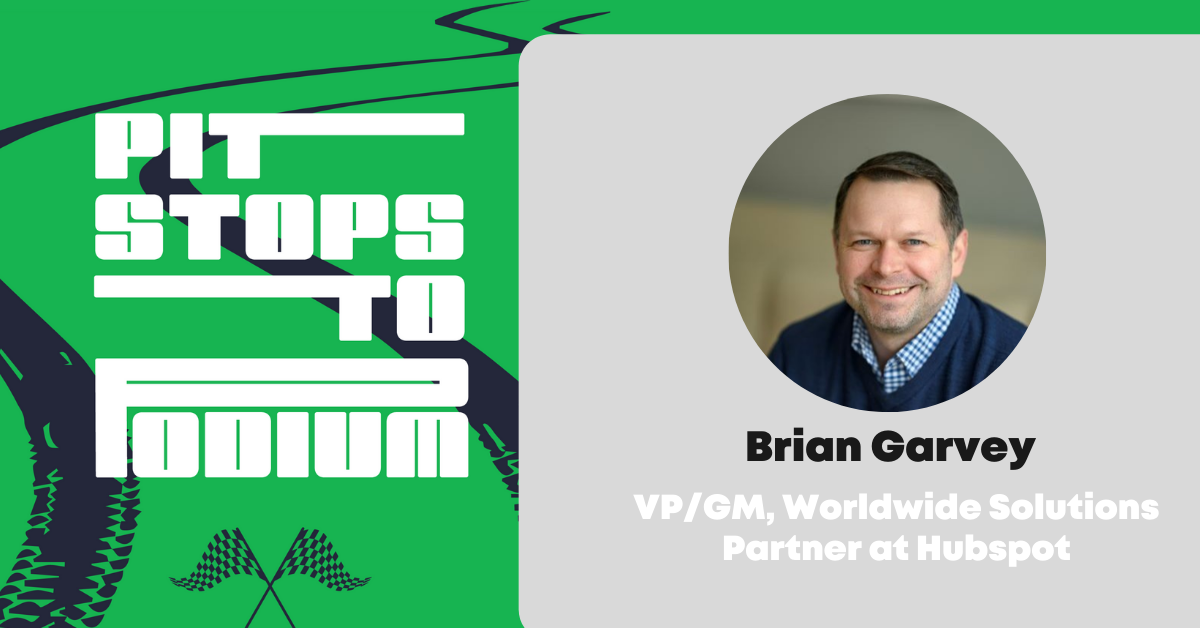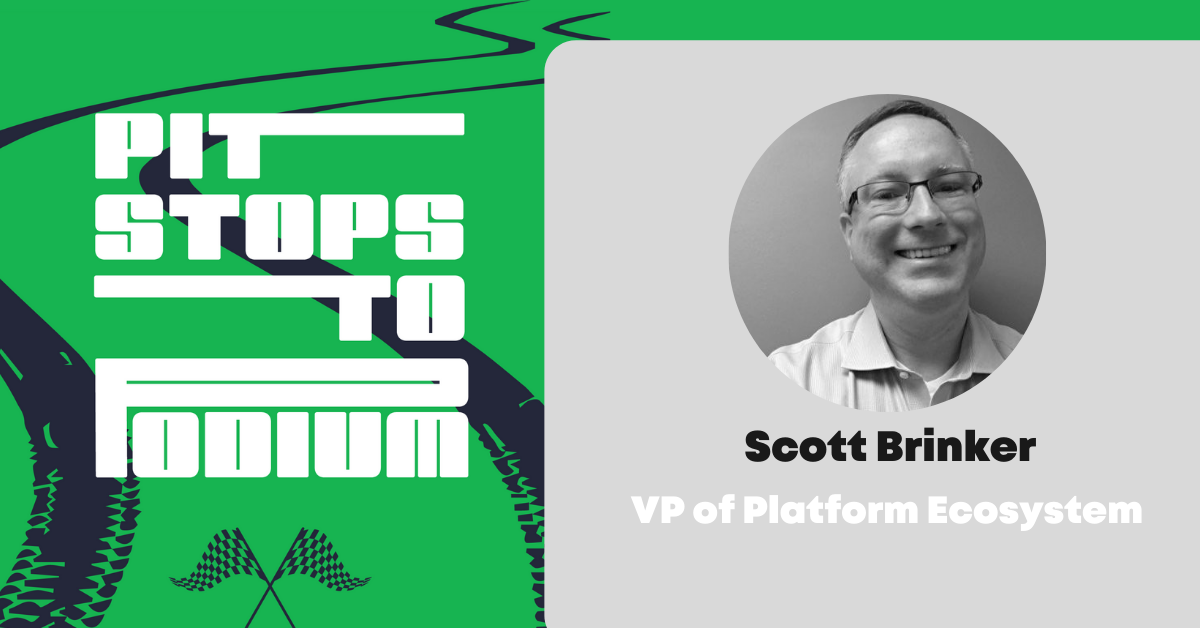Table of Contents
Putting the customer first is always the primary goal for HubSpot. But, there is a team within the company whose “customer” is somewhat more unorthodox than what people generally picture. Cody Normand, the Senior Manager for Sales Productivity and Enablement at HubSpot, shines some light onto who his team primarily serves and why it is such a crucial focus for revenue growth at HubSpot. “Our true customer, as the enablement team, is the HubSpot Seller. That is who we are serving to make them as productive as possible and remove as much friction from their days so that they can spend their time selling.” Listen to this B2B podcast as Cody goes into more detail on the structure, responsibilities, and success metrics of an Enablement Team.
Pitstop Highlights
Structuring an Enablement Team
When thinking about the structure of a successful and productive enablement team, you need to think about four main components:
-
Having a team solely focused on the seller
-
Development of a sales strategy
-
Leadership enablement: using managers and directors to support enablement initiatives
-
Field enablement: hiring enablement specialists for each of your segments and regions
What is the enablement team responsible for?
One of the biggest responsibilities of an enablement team is sales training. An enablement team often deals with onboarding and ramping new hires from day one to day 365.
Another big responsibility of enablement is launching a sales strategy. Take, for example, a product launch. Enablement will ask questions such as “Who are we selling this to?”, “What's our persona?”, or “how are we going to demo this?” Enablement ensures that the sales team is ready to successfully sell their new product and support the journey throughout the product launch.
Lastly, a huge part of the enablement team is creating streamlined communication channels. With efficient communication channels, enablement can ensure the sales team stays focused on selling–not on the distractions of slack messages and emails.
Tracking and Measuring the Success of an Enablement Team
Cody tracks and measures the successes of his team in two different ways:
Macro-level KPIs: Macro-level KPIs are often tracked through PPR and TTR. PPR (productivity per rep) deals with the total revenue in a given month divided by the number of representatives a company has. Let's say you bring in $100 in the given month and have 10 reps on the floor. 100/10 = $10 PPR. The TTR (time to ramp) deals with ramping sellers to be as productive as possible, as fast as possible. Essentially, the faster the time to ramp, the closer the company gets to breaking non-linear growth.
Micro-level KPIs: Micro-level KPIs measure and track success on a project-to-project basis. Whether through increasing ASP, decreasing discount percentage, increasing attach rate, etc. Every initiative that you work on through enablement should have outcomes to it. Having success metrics and outcomes for projects is essential in making sure the overall company goals are supported.
Connect With Cody:
- Connect on Linkedin: https://www.linkedin.com/in/cody-normand/
- Engage with Hubspot: https://www.hubspot.com/
- Check out their Free Product! https://www.hubspot.com/products/get-started
Full Transcript:
Brendan: Hey everyone, welcome to Pit Stops to Podium, the RevPartners podcast, where we talked to exec’s who competed and won, taking their companies from high growth to high scale. My name is Brendan Tolleson. I am the co-founder and CEO of RevPartners, and I'm delighted to have with me today, Cody Norman. Welcome, Cody.
Cody: Hey Brendan, how are you?
Brendan: I'm doing well. Well, hey, we are big fans of Hubspot, so it's fun to have representation from our most strategic partner. Cody currently serves as a Senior Manager for sales, productivity and enablement. You've been there for, what, six years now? Yeah, yeah, just a little bit over six years. So, Cody, let's first start before we get into the big idea and the fun facts. What is enablement for some of the folks in our audience who may not understand what that category really means?
Cody: Yeah so you know, it's a great question, and I think there's a lot of different definitions out there. But the way that we think about enablement and sales enablement at HubSpot is where our true customer and our customer is the HubSpot seller that is who we are serving to make them as productive as possible and remove as much friction from their days as frequently as possible and as much as possible so that they can spend their time selling and selling HubSpot. So at a very high level, that's how we think about it, theoretically at HubSpot.
Brendan: Great. So you're enablement and your definition is an internal function. As you mentioned, it's more the audience and the customer for you is the customer-facing rep, whether that's direct sales or partner. And based on, I mean, let's walk the audience through from a HubSpot perspective, you have almost 1,000 reps right now, but how do you when we talk about partners and direct, how does that look like in the HubSpot lens?
Cody: Yeah so those are two main segments where we have our direct Sellers and then we have our partner channel and who are really working as strategic partners. We call them channel account managers who are working with partners like yourself to help them resell HubSpot and to help your businesses grow, you know, to serve HubSpot customers and folks like that. So those are held at a high level. We have our directing partner. And then underneath that, we segment our teams out based on employee size. So small business, mid-market and then our enterprise and corporate teams is how our sales teams are segmented. Just so there's more focus on selling. Just selling HubSpot to a small businesses is a different sales process than selling HubSpot to a 2000 plus enterprise type company. Much different sales process, a lot of different needs at times, so we make sure that we're serving our prospects and customers to the best of our ability. But by segmenting our, you know, our database out in that way, yeah, it makes sense to get the credibility to use cases and to your earlier point, it reduces that friction and makes it a better experience for everyone involved.
Brendan: Let's take a pause on enablement. We'll dive deeper because as our audience can probably tell, that's where we're going for the big idea. But a tradition here at Pit Stops to Podium is to get to know our guest, outside of work. So Cody, what are three fun facts about you that our audience should know?
Cody: Three fun facts. Typically, it's always one fun fact is it's tough to drum up. Uh, I say, you know, one thing I'm super grateful for to have the experience, I was fortunate enough to play college baseball at Hofstra University in Long Island–role pride.
Brendan: What position?
Cody: I was a pitcher.
Brendan: OK, nice. Yeah was your pitch? Was it fastball? Or I mean, could you typically have it in college?
Cody: Yeah I mean, my arm was about to fall off at the time I was going to graduate, but I was a relief pitcher. By the end of my career is the changeup I really relied on. But and I think the second thing, I don't know why they let me do this, but a couple of years ago, well Nashville is now open again, but I was fortunate to go to Nashville. And they let me up on stage to play chicken fried. I still know the guy's name is Nick Smith. He's still out there chasing the dream. I still follow him on spotify, but I'll never forget that I was able to play on a national stage once.
Brendan: That's really awesome. Like you sing or play an instrument?
Cody: Yeah just played an acoustic guitar. I don't know how well I did, but it was. It was, It was a cool experience.
Brendan: We’ll have to get the video vault and find that performance and post that as part of the podcast.
Cody: Yeah, I think no, that one's got to stay buried in the depths of the internet. I think the third one is I actually graduated with a broadcast journalism degree, thought I wanted to be a sportscaster. ESPN do that whole thing and chase that dream for a couple of years and. Just wasn't it wasn't what it looks like on TV. It's just a different lifestyle, so found my way into tech sales and so glad that I did.
Brendan: Natural transition.
Cody: Yeah, definitely the best career decision pivot that I've made to this point.
Brendan: That's great. Well, you picked a winner with Hubspot, so that's fantastic ride that you've experienced and as is HubSpot. And so let's transition the big idea. We already teased out a little bit at the front end, which we normally don't do, but I thought it'd be helpful for context for audience. But let's talk about how investing in enablement really fuels that revenue engine for any scaling company. So let's break it down and kind of three major categories. Let's talk about the structure. Let's talk about responsibilities and ultimately the KPIs in terms of how you track and measure it. So how do you think about structure for a successful and productive enablement team?
Cody: Yeah so I think there's four main components that I think you need on enablement team of in terms of how you're structured. Number one, I think all encompassing, another reason of why an enablement team is so important is because you need a team that their sole focus and responsibility is thinking about the HubSpot seller or your seller, right? Thinking about the seller on the floor. A lot of times, companies, they overlook that where you're thinking so much about your customer and your market fit, which 100% you have to do, but at times you're forgetting about who's actually going to sell this and bring this to market, you need a team that is doing that. So that's how you're enablement. Teams should be structured, and the way that you can put that in play is you need strategy, you need sales strategy. So on your enablement team, you need some type of strategy arm that can put that rep hat on can say, here's what it's like to be a seller at this company. Here's what the day to day is like. Here's how we should execute. All right, so you need that strategy. You also need content creation instructional design because you're going to need to be creating programs and trainings that that, you know, are easy to take on as a seller, right? So you really need that instructional design lens to take your trainers to the next level. You also need leadership enablement. This is new. What I'm seeing in the market of managers and directors played just as much of a role in enablement as the enablement team does. And you need a way to support them. So that they can support the enablement initiatives, pass that down and coach to their reps crucial, crucial part to enablement in general. And then the fourth part is the field side, the field enablement side, which is that dedicated segment in type support, right? Especially if you're a global company and you have different types of segments where you're selling the small businesses versus mid-market versus enterprise different sales processes in different regions, right? How you might sell your product to a small business in North America versus a small business in Australia or in EMEA could be drastically different just based on cultural differences or different market fit, all that type of stuff. So you really need that segment in type lens, where you have enablement specialists for each of your segments and regions to make sure that they are going to market effectively and they have the right enablement and strategy to produce the highest results.
Brendan: Yeah, like that's almost like a 360 view of really the service component to your point around the boots on the ground, the people that are actually doing the sale and making sure they have everything they need to be successful to ultimately reduce that friction both for them, but ultimately for the customer. So you're an extension of the team, which is great. So maybe I just tease this out a little bit. Let's talk a little bit more about the responsibility side. So we talked a little bit about structure. What's the responsibility of the enablement team?
Cody: Yeah, if I boil down at a high level, it's I'd say it's training. So there's definitely like a sales training aspect, right? I think the enablement team should be responsible for onboarding and ramping your new hires from start to finish. So what is day one like at your company and to whatever your ramp time is, we'll call it day, 365 for like a year of the ramp, right? So sales training for sure. As I mentioned, the sales strategy piece and more specifically, their product launches. So something we do a lot at HubSpot and what a large responsibility is for our team is when we're launching a new product. OK, what's the who are we selling this to? What's our persona? How are we going to demo this? How do we run a discovery? Call all of that type of stuff and make sure that the sales team is 100% prepared to sell this new product, right? And then I think another piece is around communication channels, change management, and behavior change. I kind of bucket all three of those in one. I think a key part of enablement, there's so much noise that comes at any given sales team, so many changes, and really any change a company makes, it's going to impact the sales team in the sales team needs to know about it. And that can get crazy where the waters just start being super rough for sales. It's like, I got this product coming at me. I got this quarter to hit. I got this new sales ops policy. I got my manager asking, like, there's so much that a seller deals with that sometimes the company forgets about how much they're dealing with, so they need a team like an enablement to create very streamlined communication channels so that it's as calm waters as possible. So again, the sales team can stay focused on selling and they have they're not being bombarded with emails. Slack messages this all over the place. So we have a heavy, heavy emphasis on our communication channels and making sure that we have the right mechanisms to enact change in a way where it's not, you know, forceful like, hey, you've got to go do this now. It's a very top-down-driven approach, where we start with our VP level. Get their buy-in, go down the directors, go down the managers, go down to reps in a reality we try to be in an effective and as clean as possible type of way.
Brendan: I started my career in sales. And so this is like music to my ears to hear somebody that like is an advocate and an evangelist for the salespeople. And so that's not often what you hear. It's usually the opposite. And so I'm sure our audience is loving what they're hearing and we'll be advocating for the enablement team within their organization. So the last thing let's talk about is we talk about structuring Typekit responsibilities. Now, ultimately, how do you track and measure the success of an enablement team?
Cody: Yeah so the way that we look at that now kind of look at it in two different lenses, you have kind of your macro-level KPIs and then micro level where you can kind of dig in a little bit more on the inputs we'll call. So starting with just the high level of general KPIs, we look at PPR and TTR, so PPR stands for productivity per rep. And the way we calculate that at HubSpot is we take the total revenue that we brought in a given month and then you divide that by the number of reps that you have. So let's say you bring in $100 in the month, you have 10 reps on the floor under divided by 10. Basically, what that means is your PPR is $10 right? Obviously, very simple example, but that's how we calculate PPR. Then we have TTR, which is called time to ramp, and that is a crucial number for us in KPI. We obviously want to ramp our Sellers to be as productive as possible, as fast as possible. The faster we do that, the closer we get to breaking non-linear growth, which is essentially breaking the need to hire x amount of Sellers to hit a revenue goal, right? So just overall more healthy for the business if we can reduce time to ramp. So PPR TTR, the two primary KPIs we look at. But then we also look at those are very much lagging indicators that we kind of report on every quarter or half a year, et cetera. But we do also report on a project by project basis. Every initiative that you work on and enablement should have outcomes to it. Whether it's we want to increase asp, we want to decrease discount percentage, we want to increase attach rate for this given service, et cetera. So I'd highly recommend any initiative that you have going on. You should have some success metrics and outcomes to those, and those are more of the we can look at those in real time to report on a project by project basis. You kind of just build up that library of success metrics of how certain projects and initiatives have gone.
Brendan: One thing is that I love what you just said is the focus. Like you mentioned really two metrics. And for a company the size of Hubspot, this publicly traded almost 1,000 reps that you're really tracking to speaks to Hyper focus. And that's I think the temptation is always to over engineer and make sure you have like 5 to seven rocks. But really, it's hey, we did these two well and we're know we're being successful. And yet while it may be a lagging, it really kind of creates that focus and clarity in terms of what's successful, what success and what's not.
Cody: Exactly, exactly.
Brendan: Cody, I love learning more about enablement as it relates to HubSpot. I think this has been an excellent topic for a lot of our companies, as they're going from high growth to high scale when to invest in how, as we part ways, how can folks learn a bit more about you or hubspot?
Cody: Yeah, I'm active on LinkedIn. At least I try to be. So feel free to shoot me a DM or I'm always open to connecting with folks and even getting on a quick Zoom or phone call, whatever it is, feel free to shoot. Or shoot me a note, I'm happy to talk more about this topic. If you're in a phase where you're thinking about starting an enablement team more than happy just to have a super casual conversation with you.
Brendan: Great we'll call you. We really appreciate it. And if you don't want to do the DM route, then maybe when your natural, next time you'll see Cody on a bar singing some more chicken fried rice.
Cody: There you go. Hopefully, then hopefully.
Brendan: All right. Thanks so much.
Cody: Thank you. Take care.
Want to hear more from industry experts?
Come check out the full Pit Stops to Podium podcast repository!




